
Blackfriars Bridge in London, Ontario, Canada is a wrought iron bowstring arch through truss bridge, crossing the North Thames River. The bridge was constructed in 1875 and carries single-lane vehicles, bicycles and pedestrians from Blackfriars Street to Ridout Street North.

The Golden Hill Bridge is a historic bridge on Golden Hill Road over the Housatonic River in Lee, Massachusetts. It is a lenticular pony truss bridge built c. 1885 by the Berlin Iron Bridge Company, and is the state's oldest surviving bridge of this type. It is one of only five Berlin Co. bridges in the Berkshires, and is the only known surviving bridge to implement modifications to the pony truss design patented by William O. Douglas in 1885. The bridge was listed on the National Register of Historic Places in 1994.

The Hadley Parabolic Bridge, often referred to locally as the Hadley Bow Bridge, carries Corinth Road across the Sacandaga River in Hadley, New York, United States. It is an iron bridge dating from the late 19th century.
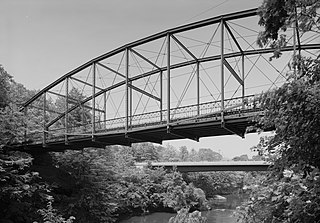
The Lover's Leap Bridge is a wrought-iron lenticular truss bridge over the Housatonic River located in Lovers Leap State Park in New Milford, Connecticut. Built in 1895 by the Berlin Iron Bridge Company, it is one of the last bridges built by the company and is a particularly ornate example of its work. It was listed on the National Register of Historic Places in 1976 and is now open only for foot traffic.

The Glen Falls Bridge is a historic bridge that formerly carried Brunswick Avenue over the Moosup River in Plainfield, Connecticut. Built in 1886 by the Berlin Iron Bridge Company, it is one of a shrinking number of surviving 19th-century lenticular truss bridges in the state. The bridge was listed on the National Register of Historic Places in 1999. It has been closed to all traffic for many years.

Ouaquaga Lenticular Truss Bridge is a historic lenticular truss bridge located at Ouaquaga in the towns of Windsor and Colesville in Broome County, New York. It was constructed in 1888 and spans the Susquehanna River. It is composed of two identical through trusses with an overall length of 343 feet (105 m). It was constructed by the Berlin Iron Bridge Co. of East Berlin, Connecticut. The bridge was closed to vehicular traffic in 2008 when a new bridge was built alongside it. The old bridge remains open for pedestrian use.
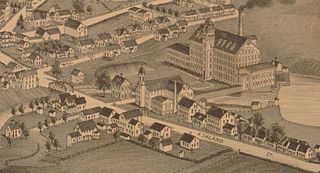
The Ashland Mill Bridge was a lenticular pony truss bridge over the Pachaug River in Griswold, Connecticut that was built in 1886 by the Berlin Iron Bridge Company. It was built following the Ashland dam break of February 1886 which washed away the previous bridges. The bridge served the millyard of the Ashland Cotton Company, in the Jewett City section of Griswold. The bridge was 65 feet (20 m) long and crossed a millrace on a skew angle. The Ashland Mill was damaged by arson in March 1995 and subsequently torn down, but the bridge itself remained. By 1999, the town deemed the bridge unsafe and closed it, and by February 1999, the bridge was moved to a vacant parking lot and was replaced with a new bridge. The bridge was added to the state of Connecticut historic register and it was later added to the National Register of Historic Places in April 1999. It was removed from the National Register in February 2016.

The Turn-of-River Bridge, also known as Old North Stamford Road Bridge, is a single-span lenticular pony truss bridge built by the Berlin Iron Bridge Company in 1892. It was listed on the National Register of Historic Places in 1987. It formerly brought the Old Stamford Road across the Rippowam River, but is now open only to pedestrian traffic, as the road ends shortly before the bridge.
The Berlin Iron Bridge Company was a Berlin, Connecticut company that built iron bridges and buildings that were supported by iron. It is credited as the architect of numerous bridges and buildings now listed on the U.S. National Register of Historic Places. It eventually became part of the American Bridge Company.

The Main Street Bridge formerly carried Main Street over the Rippowam River just outside downtown Stamford, Connecticut. It was designed and manufactured by the Berlin Iron Bridge Company in 1888. It is a two-span wrought iron lenticular truss bridge, each span 60 feet (18 m) long, although there are supporting piers every 12 feet (3.7 m) feet. The abutments and central pier are cut granite and other stone, faced in concrete.
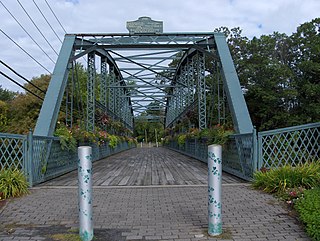
Drake Hill Road Bridge, also known as the Old Drake Hill Flower Bridge, is a bridge in Simsbury, Connecticut, originally carrying Drake Hill Road over the Farmington River. Built in 1892, it is one of three surviving Parker truss bridges in the state. It was listed on the National Register of Historic Places in 1984. It now carries foot traffic only.

The Bell Road Bridge is a Pratt through truss bridge in Dexter Township, Washtenaw County, Michigan. Built in 1891, the bridge carried Bell Road over the Huron River. Since 1997, the bridge has sat on the riverbank, overgrown with brush. The bridge is a Michigan State Historic Site and is listed on the National Register of Historic Places.

The Delhi Bridge, also known as the East Delhi Bridge, is a one-lane, wrought iron Pratt through truss bridge that carries East Delhi Road over the Huron River in Washtenaw County, Michigan. The bridge was completed October 12, 1883 to replace a wooden span built in 1851. In 1917, the bridge was severely damaged by a tornado but was rebuilt. After it was closed to traffic in 2005 for being unsafe, the bridge was renovated and reopened in 2009. The bridge is listed on the National Register of Historic Places.

The Butts Bridge carries Butts Bridge Road over the Quinebaug River in the town of Canterbury, Connecticut. It is a well-preserved example of a Parker truss, built in 1937, late in the state's regular use of steel truss bridge designs. The bridge is also known as Bridge No. 1649 and carries an average of 2,300 vehicles per day as of 2011. It was listed on the National Register of Historic Places in 2010.
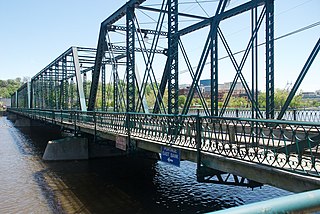
The Sixth Street Bridge is a four-span, wrought iron bridge that crosses the Grand River in Grand Rapids, Michigan. It is a Michigan State Historic Site and is listed on the National Register of Historic Places. Built in 1886, it is the longest and oldest metal truss bridge in Michigan.
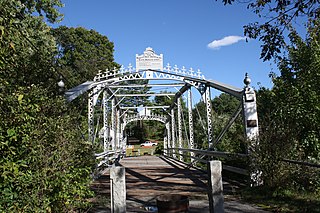
The Pineground Bridge, also known as the Depot Road Bridge or the Thunder Bridge, is a through-type lenticular truss bridge that formerly carried Depot Road over the Suncook River in Chichester, New Hampshire. The bridge was built in 1887 by the Berlin Iron Bridge Co., and is the only one of its type in the state. It is 96 feet (29 m) long and 16 feet (4.9 m) wide, and rises 15 feet (4.6 m) above the river. It is mounted on abutments made of unmortarted ashlar granite. The decking and rails are made of wood. The bridge has not undergone major alterations since its construction. Some of its stringers were replaced during the 1981-2 restoration, wooden parts were also replaced, and a number of decorative parts have been lost over the years.

The Cascade Bridge is a historic structure located in Burlington, Iowa, United States. In April 1896 the Burlington City Council approved a proposal to have city engineer S.D. Eaton advertise for plans and estimates for a bridge on Main Street that would span Cascade Ravine. The Cascade Lumber Company had petitioned for the bridge. The city contracted with the Cedar Rapids, Iowa firm of Boynton & Warriner to design the structure and the Milwaukee Bridge and Iron Works to erect the span. The city was responsible for building the concrete substructure. The bridge was completed in the fall of 1896, and is composed of four spans. The span length is 160 feet (49 m), and its total length is 464 feet (141 m). The span is a Baltimore deck truss bridge with Pratt deck trusses at both ends. The structure is supported by stone and concrete abutments with concrete pedestals and a single concrete-filled steel cylinder pier. Over the years the original deck has been replaced, and concrete has been applied to the stone abutments. Otherwise the structure has been unaltered. The bridge was listed on the National Register of Historic Places in 1998.

The Minortown Road Bridge is a historic lenticular pony truss bridge in northeastern Woodbury, Connecticut. It spans the Nonewaug River, connecting U.S. Route 6 (US 6) to Minortown Road and Mill Road. Built in 1890 by the Berlin Iron Bridge Company, it is one a small number of surviving lenticular truss bridges in the state. It was listed on the National Register of Historic Places in 2001.

The Melrose Road Bridge is a historic bridge at the western end of Melrose Road in East Windsor, Connecticut. Built in 1888, it is one of a small number of surviving 19th-century lenticular pony truss bridge in the state. It was listed on the National Register of Historic Places in 1999. It has been closed for many years, and lacks stringers and decking.

The Red Bridge is a historic bridge spanning the Quinnipiac River near Oregon Road in Meriden, Connecticut. It was built in 1891 by the Berlin Iron Bridge Company, and is one of a small number of surviving lenticular truss bridges in the state, and was listed on the [[National Register of Historic Places in 1993. The bridge is open to pedestrian traffic only.





















